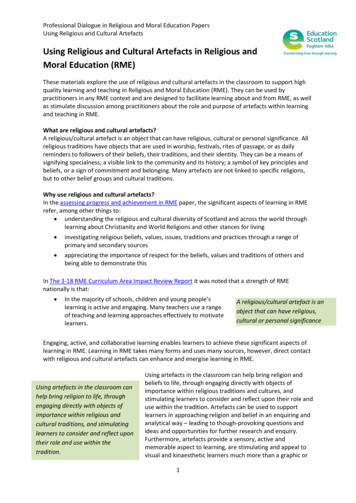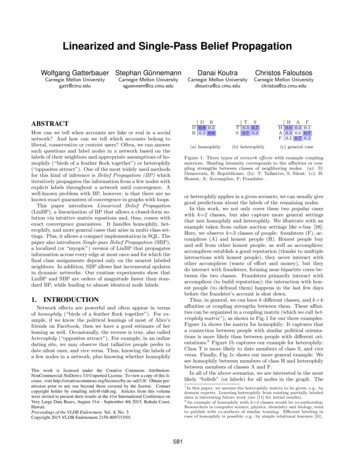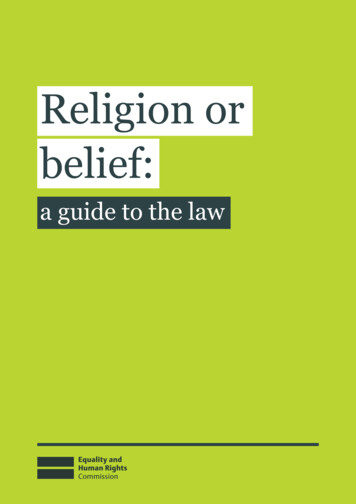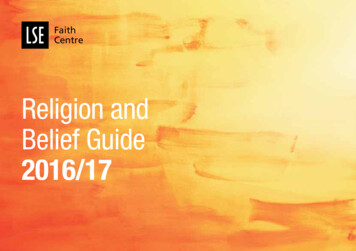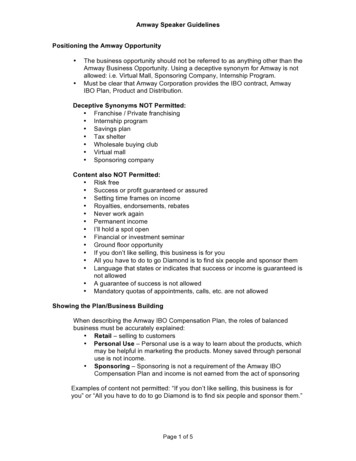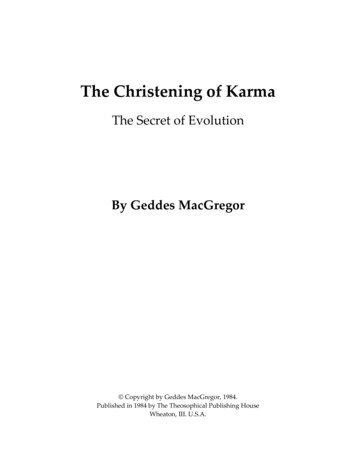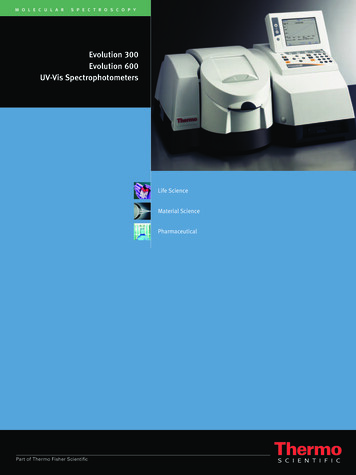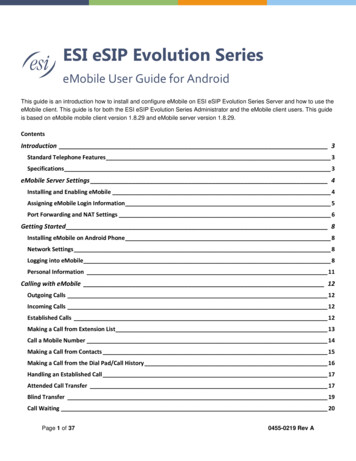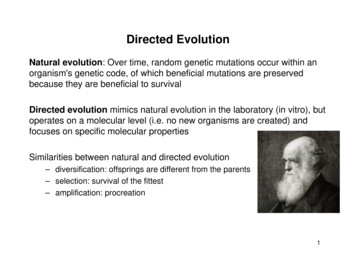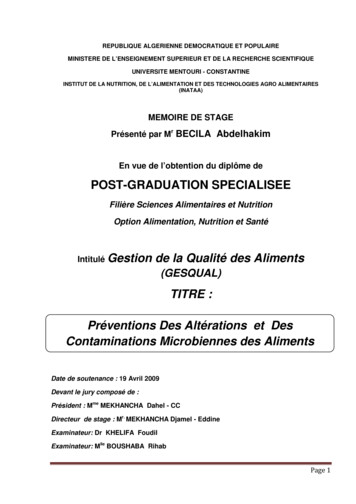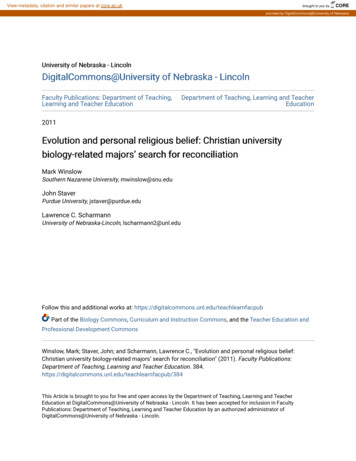
Transcription
View metadata, citation and similar papers at core.ac.ukbrought to you byCOREprovided by DigitalCommons@University of NebraskaUniversity of Nebraska - LincolnDigitalCommons@University of Nebraska - LincolnFaculty Publications: Department of Teaching,Learning and Teacher EducationDepartment of Teaching, Learning and TeacherEducation2011Evolution and personal religious belief: Christian universitybiology-related majors’ search for reconciliationMark WinslowSouthern Nazarene University, mwinslow@snu.eduJohn StaverPurdue University, jstaver@purdue.eduLawrence C. ScharmannUniversity of Nebraska-Lincoln, lscharmann2@unl.eduFollow this and additional works at: t of the Biology Commons, Curriculum and Instruction Commons, and the Teacher Education andProfessional Development CommonsWinslow, Mark; Staver, John; and Scharmann, Lawrence C., "Evolution and personal religious belief:Christian university biology-related majors’ search for reconciliation" (2011). Faculty Publications:Department of Teaching, Learning and Teacher Education. b/384This Article is brought to you for free and open access by the Department of Teaching, Learning and TeacherEducation at DigitalCommons@University of Nebraska - Lincoln. It has been accepted for inclusion in FacultyPublications: Department of Teaching, Learning and Teacher Education by an authorized administrator ofDigitalCommons@University of Nebraska - Lincoln.
digitalcommons.unl.eduEvolution and Personal Religious Belief:Christian University Biology-RelatedMajors’ Search for ReconciliationMark W. Winslow,1 John R. Staver,2 andLawrence C. Scharmann31 Southern Nazarene University, Bethany, Oklahoma 730082 Center for Research and Engagement in Science and Mathematics Education(CRESME), Purdue University, West Lafayette, Indiana 479073 School of Teacher Education, College of Education, Florida State University,Tallahassee, Florida 32306Correspondence: M.W. Winslow; email mwinslow@snu.eduAbstractThe goal of this study was to explore Christian biology-related majors’ perceptionsof conflicts between evolution and their religious beliefs. This naturalistic studyutilized a case study design of 15 undergraduate biology-related majors at or recent biology-related graduates from a mid-western Christian university. The broadsources of data were interviews, course documents, and observations. Outcomes indicate that most participants were raised to believe in creationism, but came to accept evolution through evaluating evidence for evolution, negotiating the literalnessof Genesis, recognizing evolution as a non-salvation issue, and observing professorsas Christian role models who accept evolution. This study lends heuristic insight toresearchers and educators seeking to understand the complex processes by whichChristian biology-related majors approach learning about evolution.Keywords: evolution; religious beliefs; ChristianPublished in Journal of Research in Science Teaching 48:9 (2011), pp 1026–1049.DOI 10.1002/tea.20417Copyright 2011 Wiley Periodicals, Inc. Used by permission.Submitted 3 August 2010; accepted 24 March 2011; published 29 April 2011.1
Winslow et al. in J Res Sci Teach 48 (2011)T2he scientific and religious dialectical debate regarding evolutioncontinues unabated in the United States. ‘‘Creationism,’’ the religious view that a supernatural deity has directly intervened to createthe universe, has many forms—some of which seek to discredit biological evolution and foster distrust of evolutionary science among American Christians (Scott, 2009). Christian students who attend secularor religious universities that include the topic of evolution in the science curricula may experience dissonance with their interacting notions of evolution and creationism. This study explored the processthrough which Christian biology-related majors at a Christian university sought reconciliation between their understanding of evolutionand personal religious beliefs.A broad spectrum of beliefs exists within Christian versions ofcreationism (Scott, 2009). At one end of the creationism spectrum,‘‘Young Earth Creationists’’ believe in the literal interpretation of Genesis, that the universe is 6,000–10,000 years old and that God created a multiplicity of living beings in 6 days. Another distinct groupon the creationism spectrum is the Progressive Creationists, or ‘‘OldEarth Creationists,’’ who agree with currently accepted cosmologicaland geological theories, but reject basic tenets of biological evolutionsuch as the dynamic view of speciation (Colburn & Henriques, 2006;Scott, 2009). Progressive creationists believe that God, in a supernatural act, created plant and animal life at important junctures in history. Young Earth and Progressive creationists categorically reject evolution as descent with modification from a single common ancestor.The Intelligent Design (ID) movement has found traction as an activist form of creationism in churches and school boards (Kitzmiller vs.Dover Area School Board, 2005). Its advocates posit that certain biological structures have the appearance of intelligent design (Behe,1996) and could not have come about by evolution.Religious belief does not have to preclude acceptance of evolution.Theistic evolutionists believe that God works through the laws of nature in harmony with currently accepted theories of science. Colburnand Henriques (2006) broadly define theistic evolution as a ‘‘marriageof theism and evolution’’ (p. 435). Although many theistic evolutionists maintain that God ‘‘creates’’ through natural processes, the term‘‘creationist’’ in this study applies only to Young Earth and Progressive creationists and Intelligent Design advocates opposed to the theory of evolution (Evans et al., 2010).
Winslow et al. in J Res Sci Teach 48 (2011)3Belief, Understanding, and Acceptance of EvolutionScience education research literature contains interventions to helpstudents achieve an understanding of evolutionary theory. The conceptual change model uses a constructivist approach to recognize thatthe learning of new concepts hinges upon or may be impeded by students’ existing conceptions (Wandersee, Mintzes, & Novak, 1994) andsuggest methods to foster change in the students’ conceptions (Bishop& Anderson, 1990; Demastes, Settlage, & Good, 1995). More recently,science educators have focused on teaching the nature of science topromote an acceptance of evolutionary theory (Bybee, 2004; Dagher& BouJaoude, 1997; National Academy of Sciences [NAS], 1998; Verhey, 2005). Providing students with an understanding of the nature ofscience allows them to demarcate the boundaries of and distinguishbetween knowledge claims made by science and religion.One question that emerges from science education literature is,‘‘What is the goal for evolution instruction?’’ Three terms are foundmost often within studies that articulate the goal of evolution instruction: belief, understanding, and acceptance. A number of studies focus on investigating the factors that affect students’ ‘‘belief in evolution,’’ as if belief is the goal of instruction (e.g., Bishop & Anderson,1990; Lord & Marino, 1993). For instance, McKeachie, Lin, and Strayer(2002) asked, ‘‘How does a biology course affect student beliefs aboutevolution?’’ (p. 189).Cobern (1994) argues that the primary goal of teaching evolutionary concepts is the understanding of evolution rather than a belief inevolution. However, Cobern stresses that belief should be ‘‘allowed alegitimate role in the science classroom’’ (p. 588) as personal beliefscan impede an understanding of evolution. Cobern associates beliefwith knowing that a concept is true or valid. Smith (1994) contendsthat Cobern’s view is misguided in equating the acceptance of a concept with believing that it is so. Smith agrees that students’ beliefs cansignificantly impact their learning of evolution, but writes, ‘‘The genuine scientist is bound by the rules of evidence and judges the validityof various claims on the basis of empirical evidence, not on the basisof his personal convictions, opinions, and beliefs’’ (p. 594). Scharmann(2005) also argues that the goal for biology education is not to makestudents believe in evolution. Rather, the goal is for students to ‘‘understand evolutionary theory to be the most powerful contemporary
Winslow et al. in J Res Sci Teach 48 (2011)4problem-solving tool at the disposal of the biologist [italics in original]’’ (p. 13).Several studies have addressed the relationship between an acceptance and an understanding of evolution. A study of an undergraduate non-majors biology class showed that there is no relation betweenstudents’ knowledge of evolution and their reported acceptance of it(Sinatra, Southerland, McConaughy, & Demastes, 2003). Bishop andAnderson (1990) found that an improvement in college students’ understanding of evolution ‘‘did not generally change their convictionsabout the truthfulness of the theory’’ (p. 426). In a study by Lord andMarino (1993), most of the three-quarters of the college students whosaid they thought evolution was true did not have an understanding ofthe mechanism behind it. Summarizing these studies, understandingdoes not necessitate an acceptance of evolution, nor is understandingrequired to accept evolution.In a study of university students in an upper-level evolution course,Ingram and Nelson (2006) found that although constructivist instruction significantly increased acceptance of evolution, the acceptance orrejection of evolution did not have a significant influence on students’achievement in the course. Ingram and Nelson maintain that understanding enables but does not require an acceptance of evolution.Therefore ‘‘understanding evolution is more important than accepting evolution,’’ and teachers should ask students to ‘‘strive for understanding prior to making decisions regarding acceptance of any theory’’ (Ingram & Nelson, 2006, p. 20).To summarize, many studies affirm the primary importance of understanding evolution while acknowledging the implicit goal of having students accept evolution as valid. However, nonscientific andreligious beliefs can interfere with an understanding of evolution(Meadows, Doester, & Jackson, 2000). Dagher and BouJaoude (1997)argue that rationality is not the only factor in students’ synthesis ofevolutionary theory and that prior ideas, beliefs, values and emotionsform a set of interpretive categories through which new knowledgeis incorporated. Hokayem and BouJaoude (2008) advocate for a better understanding of the relation between personal beliefs and perceptions of evolution through qualitative studies and suggest that religious beliefs ‘‘cannot be treated as misconceptions but have to beincluded as part of an individual’s ‘cultural milieu’ that requires detailed description and analysis rather than modification’’ (p. 398). This
Winslow et al. in J Res Sci Teach 48 (2011)5study specifically explored the interaction of evolution and personalreligious beliefs for Christian students learning about evolution. Theimplications are important for science education to further investigatethe complex interaction of university students’ religious beliefs with anascent understanding of evolution, and how university students whoseek to accommodate evolution in their worldview accord the salientfactors that contribute to the decision-making process.Evolution and Personal Religious BeliefsAccommodation occurs when learners are confronted with evidencethat conflicts with existing mental structures and subsequently adapttheir schema to minimize the dissonance in a process of equilibration(Renner & Stafford, 1979). The interaction of religious beliefs withlearning about evolution can represent a crisis experience for Christian college students whose principal exposure to evolution has beenthrough anti-evolutionist perspectives (Miller, 2003). Meadows et al.(2000) contend that persons whose religious beliefs are in apparentconflict with evolution may actively resist learning about evolution.Meadows et al. state, ‘‘These students do not fail to learn about evolution as teachers often think; instead, they actively choose not tolearn about evolution’’ (p. 106). In this study, the researchers postulated that participants whose religious beliefs created dissonance withtheir learning about evolution would encounter several issues beforeaccepting evolution, including: judging the credibility of evolution; aliteral interpretation of Genesis; and theological implications of evolution. These issues, though not sequential or hierarchal, may representcomponents in the reconciliation process of accommodating evolution.To accommodate evolution, the student must find the theory credible, or appearing to merit acceptance. This is a difficult step for students with creationist perspectives (Meadows et al., 2000). Many creationist activists seek to discredit evolution (Alters & Alters, 2001;Scott, 2009; Williams, 2009). Judge Jones, in his ruling in Kitzmiller v.Dover Area School District (2005), observed that ID is ‘‘premised upona false dichotomy, namely, that to the extent evolutionary theory isdiscredited, ID is confirmed’’ (p. 71). Another process in Christian university students’ accommodation of evolution is coming to terms witha viable interpretation of Genesis (Dutch, 2002). Creationist leaders
Winslow et al. in J Res Sci Teach 48 (2011)6(e.g., Ham, 1987) warn that a literary, rather than a literal interpretation, of Genesis is a dangerous, slippery slope that ‘‘undermine[s] thevery foundation of Christianity’’ (MacArthur, 2001, p. 44). Creationist students exposed to such rhetoric may need to reexamine their beliefs about Genesis before accepting evolution.Finally, creationist students who are considering evolution mayneed to deal with implications that evolution holds for their theology,including God’s interventional role in creation. In response to the contingent nature of genetic mutations, Miller (1999) asks the rhetoricalquestion: ‘‘Doesn’t the very randomness of evolution rule out any notion of divine purpose?’’ (p. 233). Some Christians struggle with evolutionary mechanisms that appear devoid of divine guidance (O’Leary,2003). Murphy (2002) writes that opposition to evolution by highlyconservative Christians ‘‘can be understood as a reaction to the claimsthat the appearance. . . of life. . . requires no special divine creativeacts—no interventions in the natural order’’ (p. 33). The critical issuein this study was whether the participants invoked scientific explanations for natural phenomena such as abiogenesis or instead leanedtowards non-scientific assertions that God specially created first lifein an act of divine intervention.To summarize, for a creationist university student, a number of issues may require deliberation in order to accommodate evolution, including coming to terms with evolution’s credibility, a non-literalistinterpretation of Genesis, and some reconciliation of God’s interventional role in nature. Full resolution on the issues may not be necessary and other factors may be present in the accommodation process,which was explored in this study. One cannot overstate that the aforementioned issues, with the exception of evolution’s credibility, are notscientific. Still, each may be important in the ‘‘crucible’’ within creationist university students’ minds that mediates the perceived dissonance between their acceptance of evolutionary theory and theirpersonal religious beliefs, and therefore was explored in this study.Study Central Questions and Sub-QuestionsThe central question that framed this study was: How do Christian biology-related majors at a Christian university reconcile evolution and
Winslow et al. in J Res Sci Teach 48 (2011)7their personal religious beliefs? Three sub-questions relevant to thecentral question were investigated: What factors influence participants’ perspectives on evolutionand creationism? What are participants’ extant views on evolution andcreationism? What aspects of evolutionary theory and personal religious beliefs create dissonance for participants?MethodsThis study utilized a socially constructed knowledge framework whichmaintains that individuals develop subjective interpretations of theirexperiences arising from their social interactions and their individualthinking (Creswell, 2003). The socially constructed knowledge claimwas well suited to this study because of the research focus on participants’ meaning making through personal experiences and how thoseconstructions influenced reconciliation of perceived conflicts betweenevolution and personal religious beliefs.Case study research focuses on holistic descriptions, in-depth analyses, and understanding of the investigated phenomenon (Merriam,1998). This naturalistic research study utilized an instrumental casestudy design (Stake, 2000). The single case was a bounded system ofundergraduate biology-related majors and recent biology-related graduates from a Christian liberal arts university. The typical site samplingstrategy was used for this study, meaning, ‘‘the site is specifically selected because it is not in any major way atypical, extreme, deviant,or intensely unusual’’ (Patton, 1990, p. 173). While a diversity of approaches exists in addressing evolution issues at Christian universities (Alters & Alters, 2001), no aspect of the study site suggested that itwas atypical of higher education institutions committed to the teaching of evolution in non-opposition to religious belief. The site for thisstudy was a Midwestern Christian university with an undergraduate enrollment of 1,200 students. The institution offers the usual variety of small university science programs including biology, chemistry, and physics degrees.
Winslow et al. in J Res Sci Teach 48 (2011)8ParticipantsThe purposeful sampling method (Patton, 1990) was employed to select ‘‘information-rich’’ cases (participants) with significant relevanceto the central question of the study. Participants were senior biologyrelated majors (biology, biology-chemistry, or biological science education) and recent graduates within the last 2 years who majoredin biology-related science, and had completed an upper-level biologycourse on evolution entitled Origins, as described in the 2005–2007university catalog:A multi-disciplinary search for the origins of the universe,galaxies, our solar system, earth, life, diversity of living organisms, and the human body. The fields of nuclear physics,astronomy, geology, embryology, comparative anatomy, genetics, cell and molecular biology, and biochemistry informthe search for physical origins. Metaphysical questions aboutorigins are informed by scholars in Biblical analysis, theology, philosophy, and literature. Each student will developan annotated bibliography and a scholarly paper integratingcourse content with his/her own worldview.The criteria optimally filtered for participants with relatively advanced biology knowledge and reasoning skills. Completion of theOrigins course guaranteed exposure to issues surrounding evolutionand creationism. Enlarging the participant pool to recent graduatesallowed for compelling reflection on college experiences. Twenty-onepotential participants were the entire cohort who had completed theOrigins course and fit the study criteria. No selection was made interms of students’ initial or final views of either science or religion.Three potential participants who were recent graduates were inaccessible and three declined participation in the study. Fifteen study participants included six female undergraduates, one male undergraduate, six female graduates and two male graduates.The Role of the ResearcherDuring the study, one of the authors was a faculty member at the studysite and as the primary researcher conducted all interviews and field
Winslow et al. in J Res Sci Teach 48 (2011)9observations. All study participants had previously taken a science orscience education course from the researcher, but no participant wasenrolled in the researcher’s courses during the research. Of the 18potential participants who were accessible and contacted for this research, 83% elected to participate in and complete the study. Despitethe busy schedules of participants, several of whom were in professional or graduate studies, participants appeared eager to help the researcher. The high participant rate indicated that the research topicwas relevant to participants and the existing rapport between the researcher and participants was a positive aspect of the study.Naturalistic inquiry is interpretive research in which the researcheris the main instrument for data collection and analysis (Merriam,1998). The biases, values, and personal experiences of the researchermay influence the research process and warrant identification in astudy (Creswell, 2003). The primary researcher’s perspectives on religious belief and evolution were rooted in growing up in a Christianhome. Having attended conservative Christian schools and a Christiancollege as a physics major with little exposure to evolution, the primary researcher was highly suspicious of biological evolution. However, over several years prior to conducting this study, the primaryresearcher came to accept evolution through reading a number ofbooks written by Christian scientists (e.g., Miller, 1999) and interacting with colleagues at the study site university who served as examples of Christians who affirmed evolution. As with any naturalistic research, this study endeavored to represent phenomena from theparticipants’ points of view (Merriam, 1998). However, the primaryresearcher’s personal experiences and altered perspectives on evolution played a key role in designing the study and interpreting the datathat represented participants’ experiences in reconciling evolution andpersonal religious belief.Limitations of the StudyThis case study was bounded to biology-related undergraduate seniorsand recent graduates from a single Christian university. The selectionof participants was purposefully designed to provide greatest insightinto the processes that university students with religious beliefs experience when studying evolution. The variety in personal values, experiences, dispositions, and backgrounds that participants naturally
Winslow et al. in J Res Sci Teach 48 (2011)10brought to the study facilitated a rich understanding of each individual and a broad, holistic picture of all participants.Data SourcesThe broad sources of data in this study included semi-structured interviews, an Evolution Attitudes survey, and scholarly papers. Datawere collected from December 2006 to August 2007. A dual interviewdesign was utilized. The first interview investigated the participants’worldview using Fowler’s (1981) structural-developmental theory of‘‘stages of faith’’ which describe the cognitive rationale and affectiveresponse in shaping one’s world. The interview protocol utilized Fowler’s Manual for Faith Development Research (Fowler, Streib, & Keller,2004). Sample questions are available as supplementary material accompanying the online article (Interview Protocol S1). Faith development interview data were analyzed and coded similarly to all the datasources in this study. As the focus of this article centers on participants’ experiences and perceptions in reconciling evolution and personal religious beliefs, the faith stage developmental outcomes are notaddressed in this paper, but are found in Winslow (2008).The creationism-evolution interview was conducted approximatelya week following the first interview and explored participants’ perceived conflicts between evolution and personal religious beliefs. Theinterview protocol, created by the primary researcher, is available assupplementary material accompanying the online article (InterviewProtocol S2). The second interview included the Evolution AttitudesSurvey (Ingram & Nelson, 2006), which helped participants transition from the first interview of faith development issues to the second interview’s exploration of evolution and creationism views, andprovided context for further exploration and clarification during theinterview. Additionally, the survey results were another source of evidence to complete a comprehensive understanding of participants’perspectives.As an Origins course assignment, participants wrote a ‘‘scholarlypaper’’ that integrated course content with their own worldview. Thescholarly paper was a rich source of information that representedthe participants’ views on evolution. The carefully prepared contentsof the scholarly paper were an effective complement to the informal,spontaneous interview responses. Prior to the second interview, the
Winslow et al. in J Res Sci Teach 48 (2011)11researcher read the participants’ scholarly papers to identify aspectsof their beliefs and views on evolution for further exploration.Participants were given opportunity to review their interview transcripts to check for accuracy and provide clarification. In addition,participants were provided personal portraits that described theirviews of creationism and evolution. Participants returned a membercheck form with feedback. The purpose of the member checks was toensure accuracy in description and fidelity to participants’ perspectives. Participants’ responses to their portraits through the memberchecks were consistently positive. Four participants requested minormodification to single paragraphs in their portraits to more accuratelyreflect their perspectives. One participant wrote on her member checkin response to her portrait, ‘‘I just read the paper-perfect! Sorry, butthere were no comments that needed to be made. You worked throughthe progression of my inner struggles precisely and represented myviews exactly. Thank you for this work.’’ Member check data were integrated into the main study data for analysis and coding.The primary researcher observed the Origins course in the spring of2007. Descriptive fieldnotes offered insights into the milieu in whichstudents processed their understanding of evolution and personal religious beliefs. The researcher observed from the back of the classroom and took notes of the professor’s presentations and professor–student interactions. All 15 participants in this study had completedOrigins in the previous 2 years before spring 2007; therefore, noneof the participants were formally observed in Origins. However, discussion with the Origins professor revealed that the course had notbeen significantly changed in the semester the researcher observedthe course, and an identical syllabus was used in the previous 2 years.Methods of AnalysisData analysis was a multi-step process that included multiple readingsand coding of the interview transcripts, documents, and fieldnotes.Scrutinizing data for regularities of words, phrases, behaviors, andparticipants’ ways of thinking enabled the identification of codes assigned to units of data. The development of codes in the first readingof both interview transcripts centered on participants’ views of creationism and evolution as well as the influences and events that fostered those perspectives. The preliminary list after the first reading
Winslow et al. in J Res Sci Teach 48 (2011)12contained 46 codes such as ‘‘parental influence,’’ ‘‘Bible,’’ ‘‘fear or anxiety,’’ and ‘‘domains of science and religion.’’ The codes were checkedwith the research questions to ensure the questions were adequatelyaddressed.The initial list of 46 codes was then used in a second reading tocode line-by-line the interview transcripts, scholarly papers, and participants’ member check forms. Any new codes that developed duringthe course of the second reading were rechecked by another searchthrough the data using key words and phrases. For example, the researcher read through participants’ key statements multiple times indeveloping their portraits after the second reading, and noticed thatmany participants referred to the scientific evidence of evolution. Although these references were subtle in the first and second majorreading of the entire data, subsequent reading revealed that manyparticipants placed an importance on evidence in coming to an acceptance of evolution, and that participants esteemed evidence in uniqueways that affected whether they accepted or rejected evolution. Consequently, the researcher searched through the data, carefully readthe poignant sections, and coded for ‘‘evidence.’’At the end of the second reading, some codes were subsumed byother codes or adapted to fit the emergent patterns. For example, aninitial reading produced the separate codes of ‘‘church pastor’’ and‘‘Sunday School teacher’’ as influences. However, after a second reading of the entire data, little distinction was needed between the twocodes and both were combined under a new code entitled, ‘‘Christianadult influence.’’ The final list of codes was streamlined to 41 codes including, for example: authors and pundits; friends; university classes;anger and frustration; love of science; pressure and conflict; abiogenesis; definitions of evolution; salvation issue, etc. Based on their commonality, the codes were aggregated into four groups: influences; expressed emotions, and attitudes; conceptions of science and evolution;and religious ideas and implications of evolution. The codes withineach of the four groups were not exclusive. For instance, the code ‘‘Bible’’ was listed under the ‘‘influences’’ group, but also related to the‘‘religious ideas and implications of evolution’’ group. The four codegroups facilitated organization of the data and offered explanatoryclarity to the codes.Coded material was consolidated from participants’ interview transcripts and documents into separate files. The winnowed data allowed
Winslow et al. in J R
belief . in evolution. However, Cobern stresses that belief should be ''allowed a legitimate role in the science classroom'' (p. 588) as personal beliefs can impede an understanding of evolution. Cobern associates belief with knowing that a concept is true or valid. Smith (1994) contends

